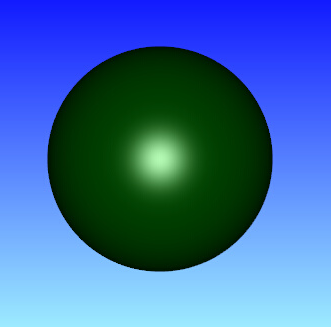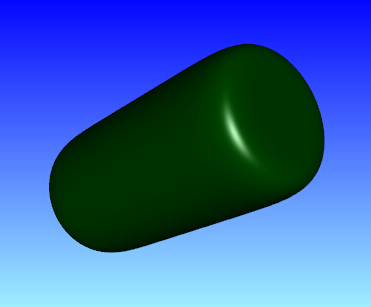4.6. Solids¶
The solids pane is used to set solids phases material properties. The “Materials” tab sets material properties shared by most models (TFM, DEM and PIC). Specific settings for each model are accessed through their respective tabs (TFM, DEM, or PIC). The SQP model requires the specification of five parameters to define the particle shape.
4.6.1. Creating a solids phase¶
A new solids phase is created by clicking the add button, ,
at the top of the solids table. This will create a new entry
in the table. The table summarizes all defined solids phases
by listing the name, model, particle diameter and density.
A blank entry in the density means the particle density is
variable (it depends on its chemical composition).
- Name
The name used to refer to the solids phase in the GUI. By default, the solids phase is called “Solid” followed by its assigned phase number. The phase number is incremented every time the
button is pressed. The solids phase name may be renamed for convenience (optional). This name will appear in other panes or tabs when referring to the solids phase (say while setting initial or boundary conditions).
Model (read only)
The modeling approach used to represent the solids phase. Available options include TFM (Two-Fluid Model), DEM (Discrete Element Model) and PIC (Particle in Cell). The setting is currently locked (the same solid model must be used for all solids phases), and mirrors the solver selection in the Model Setup pane.
4.6.2. Deleting a solids phase¶
A solids phase can be deleted by selecting it (click on its name in the
solids table) and clicking the remove button, ,
at the top of the solids table. If the solids phase is used in the
model with a non-zero solids fraction (say in an initial or
boundary condition), the deletion will need to be confirmed by the user.
If confirmed, the deleted solids volume fraction will be assigned
back to the fluid phase.
4.6.3. General solid model options¶
- Solve momentum equation (TFM only)
By default, all momentum equations are solved. Individual momentum equations may be disabled by toggling the check box.
- Solve species equations
By default, species transport equations are not solved for the solids phase. If species equations are enabled, species will need to be added to the solids phase using the solids species tool. ADD REF
4.6.4. Solids phase material properties¶
Some material properties are only needed for a specific solid model or when the energy or species equation is solved. Spherical particles (TFM, DEM, CGP, PIC) only need the Diameter to describe the particle shape. SQP particles require five parameters to define the shape, and a quaternion (4 components) to define the initial orientation.
- Diameter \((m)\) (TFM, DEM, CGP, PIC)
The initial particle diameter. It will remain constant for non-reactive flows, and for reactive flows with a variable density. If the density is constant, and chemical reactions take place, the particle diameter will vary to reflect particle mass gain/loss.
SQP parameters
The shape of non-spherical particles is defined with five parameters, \(a, b, c, m, n\). The surface of the particle is defined with the following superquadric equation:
Examples:
a |
b |
c |
m |
n |
shape |
view |
|---|---|---|---|---|---|---|
0.003 |
0.003 |
0.003 |
2.0 |
2.0 |
sphere |
|
0.003 |
0.001 |
0.006 |
2.0 |
2.0 |
ellipsoid |
|
0.003 |
0.001 |
0.006 |
8.0 |
8.0 |
cuboid |
|
0.003 |
0.003 |
0.006 |
2.0 |
8.0 |
cylinder |
- X-semiaxis \((m)\) (SQP only)
The semi axis length in the x-direction ( \(a\) in superquadric equation).
- Y-semiaxis \((m)\) (SQP only)
The semi axis length in the x-direction ( \(b\) in superquadric equation).
- Z-semiaxis \((m)\) (SQP only)
The semi axis length in the x-direction ( \(c\) in superquadric equation).
- Shape exponent m \((-)\) (SQP only)
Exponent \(m\) in superquadric equation.
- Shape exponent n \((-)\) (SQP only)
Exponent \(n\) in superquadric equation.
- Orientation (SQP only)
Four components of the quaternion \(q_1, q_2, q_3, q_4\) used for the initial orientation of particles in initial and mass inlet boundary conditions.
- Bounding diameter \((m)\) (SQP only)
Particle bounding sphere diameter. It is recommended to use the sqp designer which will automatically compute the bounding sphere diameter. If left blank, the solver will automatically compute the bounding sphere diameter at run time.
- Density \((kg/m^3)\)
The particle density can be set as:
Constant:
A positive (non-zero) number must be provided.
The diameter may change due to chemical reactions.
Variable:
The density is computed from particle’s mass and volume.
The particle mass is function of the particle’s chemical composition.
A variable density can only be used if species equations are solved.
- Viscosity \((Pa\cdot{s})\) TFM only
It may be specified using one of the following approaches:
Constant:
A positive (non-zero) number must be provided.
Continuum Solids stress Theory
User-Defined Function (UDF)
A custom equation of state must be provided in the usrproperties.f
A custom solver must be built.
- Molecular weight \(({kg}/{kmol})\)
It may only be specified using the following approach, and is only used when Energy and solids species equations are solved:
Mixture
Requires species be used to defined the solid.
Requires species mass fractions be specified for the whole domain and all flow boundary conditions
- Specific heat \(({J}/{kg\cdot{K}})\)
It may be specified using one of the following approaches (only used when Energy and species equations are solved):
Constant:
A positive (non-zero) number must be provided.
Mixture
Requires species be used to defined the fluid.
Requires species mass fractions be specified for the whole domain and all flow boundary conditions
User-Defined Function (UDF)
A custom equation of state must be provided in the usrproperties.f
A custom solver must be built.
- Thermal conductivity \(({W}/{m\cdot{K}})\)
It may be specified using one of the following approaches:
Constant:
A non-negative number must be provided.
Temperature-Dependent
Option available for TFM only.
Requires solids phase temperature be specified for the whole domain and all flow boundary conditions.
User-Defined Function (UDF)
Option available for TFM only.
A custom equation of state must be provided in the usrproperties.f
A custom solver must be built.
- Emissivity DEM only
The emissivity of the DEM solids phase. Leaving it blank or setting a zero value turns radiation off.
- Parcel weight PIC only
A default parcel weight (number of particles per parcel) may be specified for convenience (default value of one). it is used to define a default statistical weight for parcels in initial conditions regions and mass inflows. Instead of defining the same parcel weight in every initial condition and mass inflow, this default value is automatically applied. The default value can be overwritten where needed.
4.6.5. Solids Model Species¶
Specie that comprise the solid phase are summarized in the species overview
table. New species are added by clicking the add button, , at the top
of the species table.
4.6.6. Advanced settings¶
- Disable close pack (TFM only)
Options to enable/disable a TFM phase from forming a packed bed. This is typically used to make the solids phase behave as a liquid phase.
- Enable added mass force (TFM only)
Options to enable/disable the added (or virtual) mass force in a TFM phase. This tends to stabilize bubbly gas/liquid flows.
4.6.7. TFM Settings¶
Specific Two-Fluid Model settings are accessed from the TFM tab.
- Packed bed void fraction
The void fraction at close pack.
- Viscous stress model
The solids phase stress model. Options include the algebraic formulation or various kinetic theories requiring solving a partial differential equation for the granular energy:
Algebraic Formulation [DEFAULT]
Lun et al, 1984
Iddir & Arastoopour, 2005
Simonin, 1996 (requires k-ε turbulence enabled)
Cao & Ahmadi, 1995 (requires k-ε turbulence enabled)
Garzo and Dufty, 1999 (monodisperse system only)
Garzo, Tenneti, Subramaniam, Hrenya, 2012 (monodisperse system only)
Garzo, Hrenya and Dufty, 2007 - Requires at most two solids phases - Requires Wen-Yu or HYS drag model - Selection not available with added mass force
- Frictional stress model
Schaeffer model [DEFAULT]
Srivastava and Sundaresan
Only solids pressure
- Solids volume fraction at onset of friction
The minimum solids fraction above which the Srivastava and Sundaresan model sets in.
- Particle-particle restitution coefficient
The coefficient of restitution for particle-particle collision.
- Interphase friction coefficient
The coefficient of friction between particles of two solids phases.
- Angle of internal friction \((\deg)\) :
The angle of internal friction. The plastic regime stress can be turned off by setting this value to zero.
- Radial distribution function
Carnahan-Startling (only option for monodisperse systems)
Lebowitz (default for polydisperse system)
Mansoori (polydisperse system)
Modified Lebowitz (polydisperse system)
Modified Mansoori (polydisperse system)
- Stress blending
The blending function used to smooth transition around the packed bed volume fraction. It requires the Schaeffer frictional stress model.
None [DEFAULT]
Hyperbolic Tangent
Sigmodial
- Segregation slope coefficient
Coefficient used in calculating the initial slope in segregation for polydisperse systems.
- Max packing correlation
The correlation used to compute the maximum packing for polydisperse systems:
Constant [DEFAULT]
Yu & Standish
Fedors & Landel (only with two solids phases)
- Excluded volume in Boyle-Massoudi stress
The excluded volume in Boyle-Massoudi stress. It is only used with the algebraic formulation of viscous stress model (optional).
4.6.8. DEM Settings¶
Specific Discrete Element Model settings are accessed from the DEM tab.
- Enable automatic particle generation
Initialize particle location and velocity based on information from Initial Condition regions. If this option is disabled and any initial condition uses a non-zero solids volume fraction, the user will be prompted to turn on this option. Disabling this option will read initial particle location and velocity from a user generated text file (particle_input.csv) that must be saved in the project directory.
- Data file particle count
The number of particles read from particle_input.csv file when the automatic particle generation is turned off. This number must be smaller or equal to the number of lines in the file.
- Particle Size Distribution (PSD)
A series of PSDs can be defined to be used in an initial condition region or a mass inlet boundary condition. A PSD represents the number of particles having a given size. It is currently a number-based (not volume-based) distribution. A new PSD is created by clicking the add button,
, and entering the PSD parameters. The PSD can follow a Normal or Log-normal distribution. There is an option to load a text file containing a custom PSD.

Fig. 4.1 Particle Size Distribution table.¶
Initially, the table will be empty. Double click on one row to edit a PSD, Click on to remove a PSD
from the table.
First, enter a descriptive name for the PSD and choose the PSD type.
Parameters for the Normal and Log-normal distribution are:
Mean particle diameter
Standard deviation
Minimum diameter , used to clip the distribution and avoid extremely small particles
Maximum diameter , used to clip the distribution and avoid extremely large particles
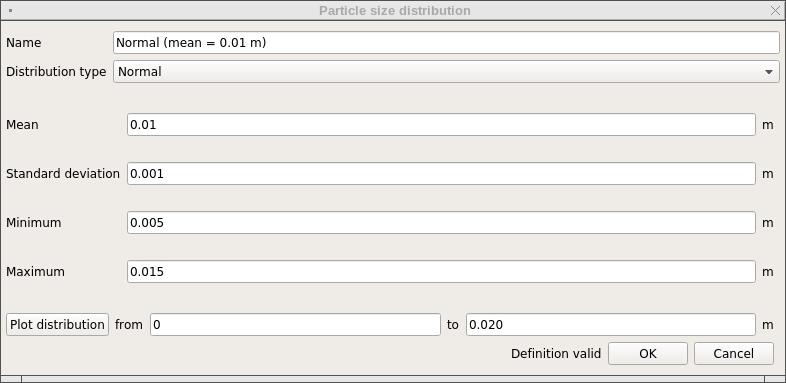
Fig. 4.2 Example of a Normal Particle Size Distribution definition.¶
Custom PSDs will read the distribution from a text file. It can be edited through any text editor including the GUI built-in editor. The PSD custom file is organized as follows:
The figure below shows an example of a custom PSD file. Only the first few lines are shown.
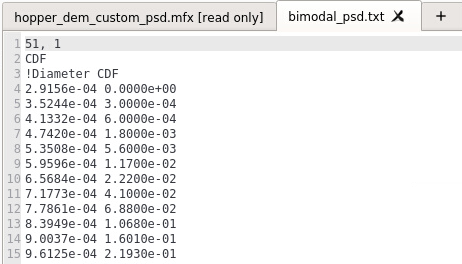
Fig. 4.3 Example of a Custom file used to define a Particle Size Distribution.¶
Once the parameters are defined, the PSD can be plotted by clicking the ‘Plot distribution’ button.
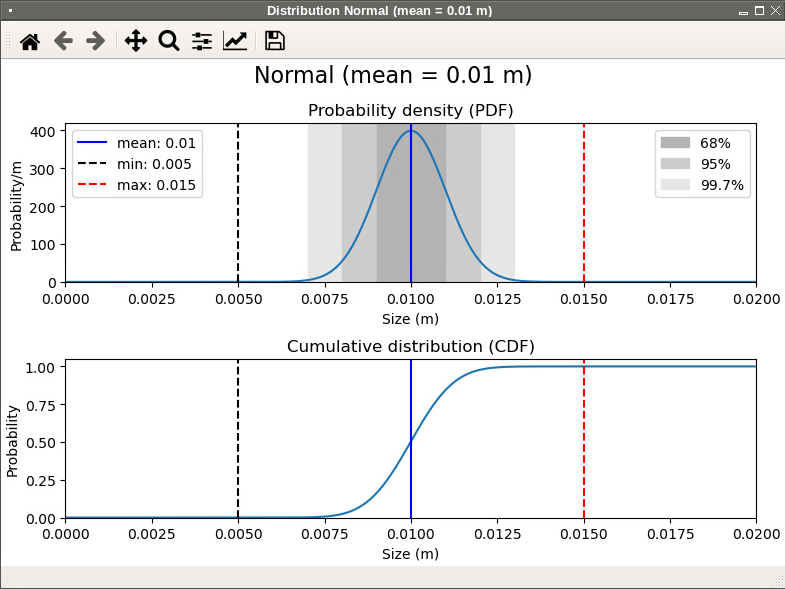
Fig. 4.4 Plotting a Particle Size Distribution.¶
- Integration method
The DEM time stepping scheme when integrating the particle trajectories (acceleration to velocity and velocity to position):
Euler [DEFAULT]
Adams-Bashforth
- Collision model
The soft-sphere collision model:
Linear Spring Dashpot (LSD)
Hertzian
- Coupling method
The level of coupling between the gas phase and the solids phase:
One-way coupled
Fully coupled
- Interpolation
The direction of interpolation between field and particle data:
No interpolation
field-to-particle and particle-to-field
field-to-particle only
particle-to-field only
- Scheme
The interpolation scheme:
None (centroid method)
Garg, 2012 (interpolation width is dictated by grid spacing)
Square DPVM (Divided Particle Volume Method), requires an interpolation width.
DPVM_satellite (SQP model only).
- Width \((m)\)
The square DPVM interpolation width.
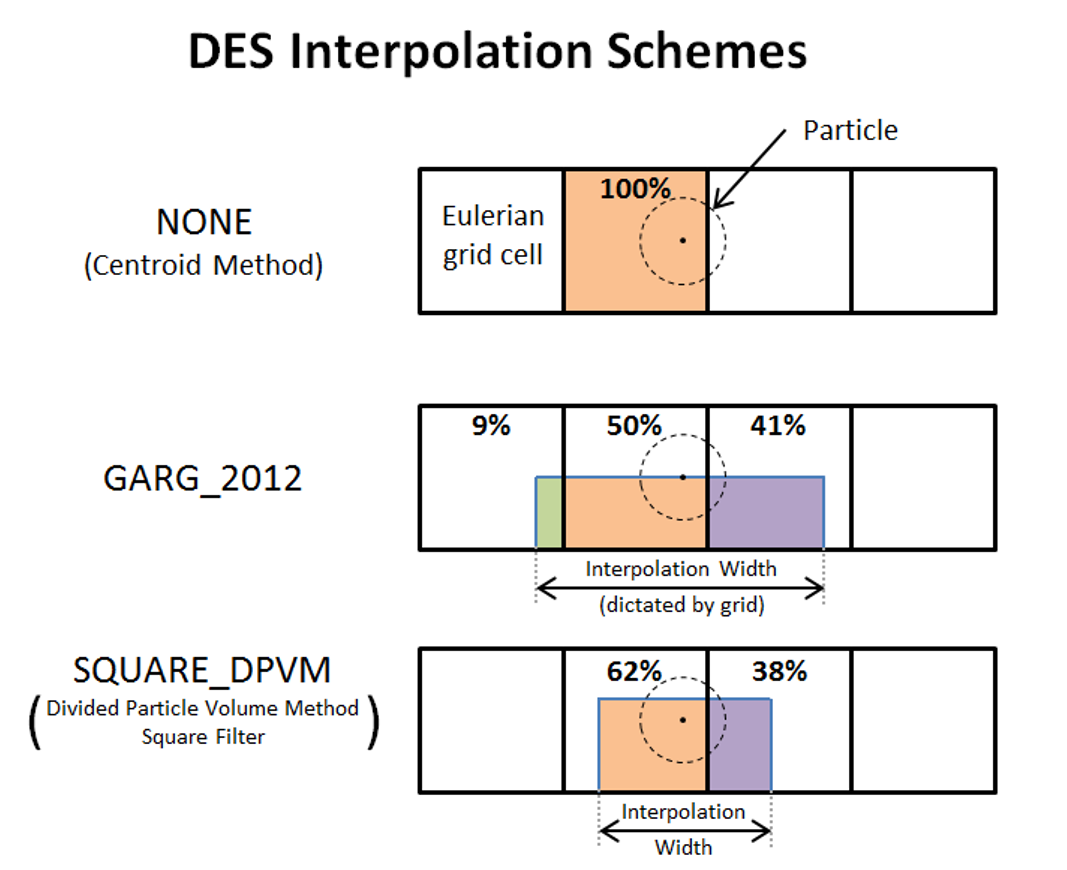
- Enable mean field diffusion
Smooths the disperse phase average fields by solving a diffusion equation.
- Width \((m)\)
The diffusion length scale.
- Enable explicit coupling of interphase quantities
Option to explicitly couple the fluid and solids hydrodynamics.
- Friction coefficient
The particle-particle and particle-wall Coulomb friction coefficient. This is required for both the LSD and Hertzian collision models.
- Normal spring constant \(({N}/{m})\)
The particle-particle and particle-wall normal spring constant (LSD collision model).
- Spring tan/norm ratio
The ratio of normal to tangential spring constants for particle-particle and particle-wall (LSD collision model).
- Damping tan/norm ratio
The ratio of normal to tangential damping factors for particle-particle and particle-wall (LSD collision model).
- Young’s modulus \((Pa)\)
The wall and particles (one entry per phase) Young’s modulus (Hertzian collision model).
- Poisson’s ratio
The wall and particles (one entry per phase) Poisson’s ratio (Hertzian collision model).
- Restitution coefficients (normal)
The list of normal restitution coefficients for particle-wall and particle-particle interaction. The particle-particle entries are arranged into a symmetrical matrix. The diagonal terms and the upper side of the matrix need to be filled. There is one entry per phase for the particle-wall coefficient. This settings is required for both the LSD and Hertzian collision models.
- Restitution coefficients (tangential)
The list of tangential restitution coefficients for particle-wall and particle-particle interaction. The particle-particle entries are arranged into a symmetrical matrix. The diagonal terms and the upper side of the matrix need to be filled. There is one entry per phase for the particle-wall coefficient. This settings is only required for the Hertzian collision model.
- Cohesion model
Toggles the van der Waals cohesion model. When turned on, additional parameters need to be set (see below):
- Hamaker constant \((J)\)
The particle-particle and particle-wall Hamaker constant used in the van der Waals cohesion model.
- Outer cutoff \((m)\)
The particle-particle and particle-wall maximum separation distances above which the van der Waals cohesion forces are set to zero.
- Inner cutoff
The particle-particle and particle-wall minimum separation distances below which the van der Waals cohesion forces are computed using a surface adhesion model.
- Asperities
The mean radius of surface asperities used in the cohesive force model.
- Minimum fluid volume fraction
Threshold used to clip the fluid phase volume fraction (to avoid non-physical values, typically when a particle size is near a small cut cell).
- Neighbor search method
The neighbor search algorithm:
Grid-based
N-Square
- Max steps between neighbor search
The maximum number of DEM iterations between two neighbor searches. The neighbor search may be called earlier if the particle moves a distance greater than a defined quantity (see below).
- Factor defining particle neighborhood
A multiplying factor applied to the particle’s radius to define the region where particle neighbors are searched from.
- Distance/diameter triggering search
The distance a particle can travel before triggering an automatic neighbor search.
- Search grid partition
The number of DEM grid cells in each direction used for the neighbor search. This is an optional setting. If left undefined, the number of cells is computed so that the DEM grid size is three times the maximum particle diameter.
- Enable user scalar tracking
Turns on the tracking of user-defined scalars attached to each particle. When the tracking is enables, the number of scalars (positive integer) needs to be set.
- Minimum conduction distance \((m)\)
The minimum separation distance between particles (used in the particle-fluid-particle conduction model to remove singularity).
- Fluid lens proportionality constant
Constant used to calculate the fluid lens radius that surrounds the particle (used in the particle-fluid-particle conduction model).
- Young’s modulus used to correct DEM conduction \((Pa)\)
The wall and particles (one entry per phase) Young’s modulus used to correct the DEM conduction. These optional input are used with both LSD and Hertzian collision models. Particles are typically made softer to increase the DEM time step. This may lead to inaccurate conduction. If defined, this Young’s modulus will be used to correct the DEM conduction model.
- Poisson’s ratio used to correct DEM conduction
The wall and particles (one entry per phase) Poisson’s ratio used to correct the DEM conduction. These optional input are used with both LSD and Hertzian collision models.
4.6.9. PIC Settings¶
Specific Particle in Cell settings are accessed from the PIC tab.
Several of the PIC settings refer to the PIC solids stress model, which influences parcel motion:
\(\tau_p={P_p \epsilon_p^\gamma}/{\max[\epsilon_{cp} - \epsilon_p , \delta(1-\epsilon_p)]}\)
- Void fraction at close pack
The void fraction \((\epsilon_{cp})\) at maximum packing.
- Volume fraction exponential scale factor
The empirical exponent \((\gamma)\) on solids fraction in the solids stress model. Typical values are between 2.0 to 5.0.
- Pressure linear scale factor \((Pa)\)
The empirical pressure \((P_p)\) constant in the solids stress model. Typical values are 10 to 1000 Pa.
- Empirical dampening factor
A factor in a restitution coefficient for comparing solids stress with slip velocity. Typical value is 0.85.
- Non-singularity constant
The constant \((\delta)\) to prevent division by zero in solids stress model. Typical value is 1.0E-8.
- Wall normal restitution coefficient
The parcel-wall restitution coefficient for normal velocity component after wall collision.
- Wall tangential restitution coefficient
The parcel-wall restitution coefficient for tangential velocity component after wall collision.
- Solids slip velocity scale factor
A damping coefficient on slip velocity. Typical value is 1.0.
4.6.10. Particle data files¶
A new and unified version of particle data files is employed in MFiX as of version 24.3. Instead of using plain text files, the new version utilizes the CSV (comma-separated values) format. It supports the discrete element model (DEM) and its variant models: Superquadric DEM (SQP), Glued-sphere DEM (GSP), and Coarse-grained DEM (CGP).
The main reason for switching from a plain text format to a CSV format is to provide greater convenience for the user to edit particle data files and set up their own simulations. Moreover, the unified version facilitates the management of particle data files.
Overview of particle_input.csv
To use the CSV file as input, go to the Solids pane and select the solids model tab (DEM, CGP, SQP, or GSP). Uncheck “Enable automatic particle generation” and enter a positive integer for the “Data file particle count”. This number must be smaller or equal to the number of particles in the CSV file.
A
particle_input.csvfile consists of a header line and values for each particle variable. The number of columns represents the number of particle variables, and the number of rows represents the number of particles (excluding the first header line). A template ofparticle_input.csvwill be provided in this user manual.
Major components of the csv file
1. must have variables: the first 3 columns (2 columns in 2D) represent particle locations. The particle position information is required in this data file, and it must be in the first three columns, or the first two columns if it is 2D.
2. extra variables: the input files can also have phase IDs, diameters, densities, and velocities. When energy or species are solved, or when using user scalar variables, the input files can include temperatures, species compositions, or user scalar variables.
3. model specific variables: For DEM sub-solvers (SQP, GSP, CGP), the input file can also provide model-specific variables such as superquadric parameters (SQP), particle orientations (SQP and GSP), or statistical weights (CGP).
- Format of header
The header names have specific restrictions, and the user is expected to follow the naming conventions provided in the template. Note that all header names are case-insensitive. A brief explanation of each header name can be found below:
X, Y, Z: particle locationsphase_id: phase ids, which phase the current particle belongs to.diameter: particle diameters, for specific sub dem model, the definition is different and it will be explained in the template section.density: particle densities.U, V, W: particle velocities in X, Y, Z directions.t_s: particle temperatures.species1, species2, ...: species fractions, header names for species columns are formatted as “species” followed by a number, where the number represents the species count.usr_var1, usr_var2, ...: user scalar variables, similar as species, header names for user scalar columns are formatted as “usr_var” followed by a number, where the number represents the user scalar variables count.
header names for model specific variables are listed below:
sqp_a, sqp_b, sqp_c, sqp_m, sqp_n, sqp_q1, sqp_q2, sqp_q3, sqp_q4: Superquadric particles semi-axis, roundness and particle orientations.gsp_q1, gsp_q2, gsp_q3, gsp_q4: Glued-sphere particles orientations.cgp_stat_wt: Coarse-grained particles statistical weight.
- Format of values
Generally, the user can use float format for all values. If the user prefers scientific notation, for example, 10000.0 can be written as 1.0e+04, and 0.001 can be written as 1.0e-03. Although variables such as
phase_idandcgp_stat_wtare integers, the format does not really matter in this file. Maintaining the correct format is highly recommended for clarity.- Data file particle count
The user is required to provide the number of particles when automatic particle generation is turned off. This number must be less than or equal to the number of lines in the file (excluding the header line). Note: For the GSP model, this value represents the number of glued sphere particles (not the number of component spheres!).
- Particle data output
In the MFiX as of version 24.3, all DEM models support saving particle data into a CSV file for future use.
4.6.11. Particle data file templates¶
As of MFIX version 24.3.1, apart from the X, Y, Z columns (X, Y columns in 2D), all other variable columns
are optional. When these columns are not present in the CSV file, the particle variables will either be automatically populated
with the values set in the GUI or assigned default values directly.
- Discrete element model (DEM)
Table 4.1 Template for DEM model here¶X
Y
Z
phase_id
diameter
density
U
V
W
t_s
species1
species2
usr_var1
0.008
0.01
0.008
1
0.0112
682
0
0
0
293.15
0.85
0.15
5
0.025
0.01
0.008
1
0.0112
682
0
0
0
293.15
0.84
0.16
5
0.042
0.01
0.008
1
0.0112
682
0
0
0
293.15
0.83
0.17
5
0.058
0.01
0.008
1
0.0112
682
0
0
0
293.15
0.82
0.18
5
0.075
0.01
0.008
1
0.0112
682
0
0
0
293.15
0.81
0.19
5
0.092
0.01
0.008
1
0.0112
682
0
0
0
293.15
0.8
0.2
5
0.008
0.01
0.025
1
0.0112
682
0
0
0
293.15
0.79
0.21
5
0.025
0.01
0.025
1
0.0112
682
0
0
0
293.15
0.78
0.22
5
0.042
0.01
0.025
1
0.0112
682
0
0
0
293.15
0.77
0.23
5
0.058
0.01
0.025
1
0.0112
682
0
0
0
293.15
0.76
0.24
5
If the energy equation is not solved, the
t_scolumn is not needed in the file. Similarly,speciesandusr_varcolumns can be removed from the data file if not using species equations and user scalar variables.- Superquadric DEM (SQP)
For SQP, the diameter is actually the bounding diameter.
sqp_a,sqp_b,sqp_care semi-axis,sqp_m,sqp_nare roundness,sqp_q1,sqp_q2,sqp_q3andsqp_q4are orientations, respectively. If they are not present in the file, those particle variables are read from GUI directly. The user can explicitly provide all the particle variables for greater flexibility and control.Table 4.2 Template for SQP model here¶X
Y
Z
phase_id
diameter
density
U
V
W
t_s
species1
species2
usr_var1
sqp_a
sqp_b
sqp_c
sqp_m
sqp_n
sqp_q1
sqp_q2
sqp_q3
sqp_q4
0.008
0.01
0.008
1
0.011
682
0
0
0
293.15
0.99
0.01
5
0.005
0.005
0.0025
2
8
1
0
0
0
0.025
0.01
0.008
1
0.011
682
0
0
0
293.15
0.95
0.05
5
0.005
0.005
0.0025
2
8
1
0
0
0
0.042
0.01
0.008
1
0.011
682
0
0
0
293.15
0.91
0.09
5
0.005
0.005
0.0025
2
8
1
0
0
0
0.058
0.01
0.008
1
0.011
682
0
0
0
293.15
0.87
0.13
5
0.005
0.005
0.0025
2
8
1
0
0
0
0.075
0.01
0.008
1
0.011
682
0
0
0
293.15
0.83
0.17
5
0.005
0.005
0.0025
2
8
1
0
0
0
0.092
0.01
0.008
1
0.011
682
0
0
0
293.15
0.79
0.21
5
0.005
0.005
0.0025
2
8
1
0
0
0
0.008
0.01
0.025
1
0.011
682
0
0
0
293.15
0.75
0.25
5
0.005
0.005
0.0025
2
8
1
0
0
0
0.025
0.01
0.025
1
0.011
682
0
0
0
293.15
0.71
0.29
5
0.005
0.005
0.0025
2
8
1
0
0
0
0.042
0.01
0.025
1
0.011
682
0
0
0
293.15
0.67
0.33
5
0.005
0.005
0.0025
2
8
1
0
0
0
0.058
0.01
0.025
1
0.011
682
0
0
0
293.15
0.63
0.37
5
0.005
0.005
0.0025
2
8
1
0
0
0
- Glued-sphere DEM (GSP)
For GSP, the diameter is actually the bounding diameter. Once the user generates a gsp configuration through MFIX GUI, the bounding diameter is automatically calculated for the user to use in this file. However, the user has the freedom to adjust the bounding diameter to adjust the particle size while maintaining the particle shape.
Table 4.3 Template for GSP model here¶X
Y
Z
phase_id
diameter
density
U
V
W
t_s
species1
species2
usr_var1
usr_var2
gsp_q1
gsp_q2
gsp_q3
gsp_q4
0.008
0.01
0.008
1
0.0112
682
0
0
0
293.15
0.9
0.1
1.5
2.5
1
0
0
0
0.025
0.01
0.008
1
0.0112
682
0
0
0
293.15
0.9
0.1
1.5
2.5
1
0
0
0
0.042
0.01
0.008
1
0.0112
682
0
0
0
293.15
0.9
0.1
1.5
2.5
1
0
0
0
0.058
0.01
0.008
1
0.0112
682
0
0
0
293.15
0.9
0.1
1.5
2.5
1
0
0
0
0.075
0.01
0.008
1
0.0112
682
0
0
0
293.15
0.9
0.1
1.5
2.5
1
0
0
0
0.092
0.01
0.008
1
0.0112
682
0
0
0
293.15
0.9
0.1
1.5
2.5
1
0
0
0
0.008
0.01
0.025
1
0.0112
682
0
0
0
293.15
0.9
0.1
1.5
2.5
1
0
0
0
0.025
0.01
0.025
1
0.0112
682
0
0
0
293.15
0.9
0.1
1.5
2.5
1
0
0
0
0.042
0.01
0.025
1
0.0112
682
0
0
0
293.15
0.9
0.1
1.5
2.5
1
0
0
0
0.058
0.01
0.025
1
0.0112
682
0
0
0
293.15
0.9
0.1
1.5
2.5
1
0
0
0
Since a GSP is a collection of smaller component spheres, so in
particle_input.csv, values of temperature, species and user scalar variables will apply to all component spheres within the same gsp, in other words, a GSP has a uniform intra-particle distribution of temperature, species and user scalar variables. However, user can provide an extra file to achieve a non-uniform intra-particle distribution, the density distribution can be non-uniformly as well. Note that the ID here is for component sphere ids, when solver detects this file, it will override the component sphere variables using the values from this extra file. This extra file is named asintra_distribution.csv(Only 3 component spheres are shown as an illustration):Table 4.4 Template for GSP intra-particle distribution here¶ID
Density
t_s
species1
species2
usr_var1
usr_var2
1
682
305.78
0.8
0.2
1.5
2.5
2
682.1
305.78
0.8
0.2
1.6
2.6
3
682.2
295.72
0.8
0.2
1.7
2.7
4
682.3
295.72
0.8
0.2
1.8
2.8
5
682.4
305.29
0.8
0.2
1.9
2.9
6
682.5
305.29
0.8
0.2
2.0
3.0
7
682.6
295.74
0.8
0.2
2.1
3.1
8
682.7
295.74
0.8
0.2
2.2
3.2
9
682.8
289.75
0.8
0.2
2.3
3.3
10
682.9
289.75
0.8
0.2
2.4
3.4
11
683
295.61
0.8
0.2
2.5
3.5
12
683.1
295.61
0.8
0.2
2.6
3.6
13
683.2
305.78
0.8
0.2
2.7
3.7
14
683.3
305.78
0.8
0.2
2.8
3.8
15
683.4
295.72
0.8
0.2
2.9
3.9
16
683.5
295.72
0.8
0.2
3.0
4.0
17
683.6
305.29
0.8
0.2
3.1
4.1
18
683.7
305.29
0.8
0.2
3.2
4.2
19
683.8
305.78
0.8
0.2
3.3
4.3
20
683.9
305.78
0.8
0.2
3.4
4.4
21
684
295.71
0.8
0.2
3.5
4.5
22
684.1
295.71
0.8
0.2
3.6
4.6
23
684.2
305.28
0.8
0.2
3.7
4.7
24
684.3
305.28
0.8
0.2
3.8
4.8
25
684.4
295.74
0.8
0.2
3.9
4.9
26
684.5
295.74
0.8
0.2
4.0
5.0
27
684.6
289.75
0.8
0.2
4.1
5.1
28
684.7
289.75
0.8
0.2
4.2
5.2
29
684.8
295.61
0.8
0.2
4.3
5.3
30
684.9
295.61
0.8
0.2
4.4
5.4
31
685
305.78
0.8
0.2
4.5
5.5
32
685.1
305.78
0.8
0.2
4.6
5.6
33
685.2
295.71
0.8
0.2
4.7
5.7
34
685.3
295.71
0.8
0.2
4.8
5.8
35
685.4
305.28
0.8
0.2
4.9
5.9
36
685.5
305.28
0.8
0.2
5.0
6.0
37
685.6
305.78
0.8
0.2
5.1
6.1
38
685.7
305.78
0.8
0.2
5.2
6.2
39
685.8
295.72
0.8
0.2
5.3
6.3
40
685.9
295.72
0.8
0.2
5.4
6.4
41
686
305.29
0.8
0.2
5.5
6.5
42
686.1
305.29
0.8
0.2
5.6
6.6
43
686.2
295.74
0.8
0.2
5.7
6.7
44
686.3
295.74
0.8
0.2
5.8
6.8
45
686.4
289.75
0.8
0.2
5.9
6.9
46
686.5
289.75
0.8
0.2
6.0
7.0
47
686.6
295.61
0.8
0.2
6.1
7.1
48
686.7
295.61
0.8
0.2
6.2
7.2
49
686.8
305.78
0.8
0.2
6.3
7.3
50
686.9
305.78
0.8
0.2
6.4
7.4
51
687
295.72
0.8
0.2
6.5
7.5
52
687.1
295.72
0.8
0.2
6.6
7.6
53
687.2
305.29
0.8
0.2
6.7
7.7
54
687.3
305.29
0.8
0.2
6.8
7.8
55
687.4
305.78
0.8
0.2
6.9
7.9
56
687.5
305.78
0.8
0.2
7.0
8.0
57
687.6
295.72
0.8
0.2
7.1
8.1
58
687.7
295.72
0.8
0.2
7.2
8.2
59
687.8
305.28
0.8
0.2
7.3
8.3
60
687.9
305.28
0.8
0.2
7.4
8.4
61
688
295.74
0.8
0.2
7.5
8.5
62
688.1
295.74
0.8
0.2
7.6
8.6
63
688.2
289.75
0.8
0.2
7.7
8.7
64
688.3
289.75
0.8
0.2
7.8
8.8
65
688.4
295.61
0.8
0.2
7.9
8.9
66
688.5
295.61
0.8
0.2
8.0
9.0
67
688.6
305.78
0.8
0.2
8.1
9.1
68
688.7
305.78
0.8
0.2
8.2
9.2
69
688.8
295.72
0.8
0.2
8.3
9.3
70
688.9
295.72
0.8
0.2
8.4
9.4
71
689
305.28
0.8
0.2
8.5
9.5
72
689.1
305.28
0.8
0.2
8.6
9.6
73
689.2
305.78
0.8
0.2
8.7
9.7
74
689.3
305.78
0.8
0.2
8.8
9.8
75
689.4
295.72
0.8
0.2
8.9
9.9
76
689.5
295.72
0.8
0.2
9.0
10.0
77
689.6
305.29
0.8
0.2
9.1
10.1
78
689.7
305.29
0.8
0.2
9.2
10.2
79
689.8
295.74
0.8
0.2
9.3
10.3
80
689.9
295.74
0.8
0.2
9.4
10.4
81
690
289.75
0.8
0.2
9.5
10.5
82
690.1
289.75
0.8
0.2
9.6
10.6
83
690.2
295.61
0.8
0.2
9.7
10.7
84
690.3
295.61
0.8
0.2
9.8
10.8
85
690.4
305.78
0.8
0.2
9.9
10.9
86
690.5
305.78
0.8
0.2
10.0
11.0
87
690.6
295.72
0.8
0.2
10.1
11.1
88
690.7
295.72
0.8
0.2
10.2
11.2
89
690.8
305.29
0.8
0.2
10.3
11.3
90
690.9
305.29
0.8
0.2
10.4
11.4
91
691
305.78
0.8
0.2
10.5
11.5
92
691.1
305.78
0.8
0.2
10.6
11.6
93
691.2
295.72
0.8
0.2
10.7
11.7
94
691.3
295.72
0.8
0.2
10.8
11.8
95
691.4
305.28
0.8
0.2
10.9
11.9
96
691.5
305.28
0.8
0.2
11.0
12.0
97
691.6
295.74
0.8
0.2
11.1
12.1
98
691.7
295.74
0.8
0.2
11.2
12.2
99
691.8
289.75
0.8
0.2
11.3
12.3
100
691.9
289.75
0.8
0.2
11.4
12.4
101
692
295.61
0.8
0.2
11.5
12.5
102
692.1
295.61
0.8
0.2
11.6
12.6
103
692.2
305.78
0.8
0.2
11.7
12.7
104
692.3
305.78
0.8
0.2
11.8
12.8
105
692.4
295.72
0.8
0.2
11.9
12.9
106
692.5
295.72
0.8
0.2
12.0
13.0
107
692.6
305.28
0.8
0.2
12.1
13.1
108
692.7
305.28
0.8
0.2
12.2
13.2
109
692.8
305.78
0.8
0.2
12.3
13.3
110
692.9
305.78
0.8
0.2
12.4
13.4
111
693
295.72
0.8
0.2
12.5
13.5
112
693.1
295.72
0.8
0.2
12.6
13.6
113
693.2
305.29
0.8
0.2
12.7
13.7
114
693.3
305.29
0.8
0.2
12.8
13.8
115
693.4
295.74
0.8
0.2
12.9
13.9
116
693.5
295.74
0.8
0.2
13.0
14.0
117
693.6
289.75
0.8
0.2
13.1
14.1
118
693.7
289.75
0.8
0.2
13.2
14.2
119
693.8
295.62
0.8
0.2
13.3
14.3
120
693.9
295.62
0.8
0.2
13.4
14.4
121
694
305.78
0.8
0.2
13.5
14.5
122
694.1
305.78
0.8
0.2
13.6
14.6
123
694.2
295.72
0.8
0.2
13.7
14.7
124
694.3
295.72
0.8
0.2
13.8
14.8
125
694.4
305.29
0.8
0.2
13.9
14.9
126
694.5
305.29
0.8
0.2
14.0
15.0
127
694.6
305.78
0.8
0.2
14.1
15.1
128
694.7
305.78
0.8
0.2
14.2
15.2
129
694.8
295.72
0.8
0.2
14.3
15.3
130
694.9
295.72
0.8
0.2
14.4
15.4
131
695
305.29
0.8
0.2
14.5
15.5
132
695.1
305.29
0.8
0.2
14.6
15.6
133
695.2
295.74
0.8
0.2
14.7
15.7
134
695.3
295.74
0.8
0.2
14.8
15.8
135
695.4
289.75
0.8
0.2
14.9
15.9
136
695.5
289.75
0.8
0.2
15.0
16.0
137
695.6
295.61
0.8
0.2
15.1
16.1
138
695.7
295.61
0.8
0.2
15.2
16.2
139
695.8
305.78
0.8
0.2
15.3
16.3
140
695.9
305.78
0.8
0.2
15.4
16.4
141
696
295.72
0.8
0.2
15.5
16.5
142
696.1
295.72
0.8
0.2
15.6
16.6
143
696.2
305.29
0.8
0.2
15.7
16.7
144
696.3
305.29
0.8
0.2
15.8
16.8
145
696.4
305.78
0.8
0.2
15.9
16.9
146
696.5
305.78
0.8
0.2
16.0
17.0
147
696.6
295.72
0.8
0.2
16.1
17.1
148
696.7
295.72
0.8
0.2
16.2
17.2
149
696.8
305.29
0.8
0.2
16.3
17.3
150
696.9
305.29
0.8
0.2
16.4
17.4
151
697
295.74
0.8
0.2
16.5
17.5
152
697.1
295.74
0.8
0.2
16.6
17.6
153
697.2
289.75
0.8
0.2
16.7
17.7
154
697.3
289.75
0.8
0.2
16.8
17.8
155
697.4
295.61
0.8
0.2
16.9
17.9
156
697.5
295.61
0.8
0.2
17.0
18.0
157
697.6
305.78
0.8
0.2
17.1
18.1
158
697.7
305.78
0.8
0.2
17.2
18.2
159
697.8
295.72
0.8
0.2
17.3
18.3
160
697.9
295.72
0.8
0.2
17.4
18.4
161
698
305.29
0.8
0.2
17.5
18.5
162
698.1
305.29
0.8
0.2
17.6
18.6
163
698.2
305.78
0.8
0.2
17.7
18.7
164
698.3
305.78
0.8
0.2
17.8
18.8
165
698.4
295.72
0.8
0.2
17.9
18.9
166
698.5
295.72
0.8
0.2
18.0
19.0
167
698.6
305.28
0.8
0.2
18.1
19.1
168
698.7
305.28
0.8
0.2
18.2
19.2
169
698.8
295.74
0.8
0.2
18.3
19.3
170
698.9
295.74
0.8
0.2
18.4
19.4
171
699
289.75
0.8
0.2
18.5
19.5
172
699.1
289.75
0.8
0.2
18.6
19.6
173
699.2
295.61
0.8
0.2
18.7
19.7
174
699.3
295.61
0.8
0.2
18.8
19.8
175
699.4
305.78
0.8
0.2
18.9
19.9
176
699.5
305.78
0.8
0.2
19.0
20.0
177
699.6
295.72
0.8
0.2
19.1
20.1
178
699.7
295.72
0.8
0.2
19.2
20.2
179
699.8
305.28
0.8
0.2
19.3
20.3
180
699.9
305.28
0.8
0.2
19.4
20.4
The number of particles given in GUI will be the number of glued sphere particles. For example, if a GSP is a collection of 8 component spheres and there are total 20 gsps, the total number of component spheres in the system will be 160, and this value will be automatically calculated by the solver. Moreover, each glued sphere particle and each component sphere will be assigned a unique id.
- Coarse-grained discrete element model (CGDEM)
For CGP, diameter is coarse-grained particle diameter, users can provide
cgp_stat_wt(coarse-grained statistical weight).Table 4.5 Template for CGDEM model here¶X
Y
Z
phase_id
diameter
density
U
V
W
t_s
species1
species2
usr_var1
cgp_stat_wt
0.008
0.01
0.008
1
0.0112
682
0
0
0
293.15
0.85
0.15
9.5
8
0.025
0.01
0.008
1
0.0112
682
0
0
0
293.15
0.86
0.14
9.5
8
0.042
0.01
0.008
1
0.0112
682
0
0
0
293.15
0.87
0.13
9.5
8
0.058
0.01
0.008
1
0.0112
682
0
0
0
293.15
0.88
0.12
9.5
8
0.075
0.01
0.008
1
0.0112
682
0
0
0
293.15
0.89
0.11
9.5
8
0.092
0.01
0.008
1
0.0112
682
0
0
0
293.15
0.9
0.1
9.5
8
0.008
0.01
0.025
1
0.0112
682
0
0
0
293.15
0.91
0.09
9.5
8
0.025
0.01
0.025
1
0.0112
682
0
0
0
293.15
0.92
0.08
9.5
8
0.042
0.01
0.025
1
0.0112
682
0
0
0
293.15
0.93
0.07
9.5
8
0.058
0.01
0.025
1
0.0112
682
0
0
0
293.15
0.94
0.06
9.5
8
4.6.12. Particle data file editor¶
The particle input file must be created in or copied to the project directory. It can be edited from the GUI. Select the Editor Tab at the bottom and select particle_input.csv from the Project files listing. The file will open in a new editor tab, and will be displayed as a spreadsheet. Each line corresponds to a particle. Data can be modified by selecting a cell and entering the new value. Operations on an entire column (say to set a constant value to the entire column) can be performed by right-clicking on the column header. Please note that the column name, content and order are specific to a given model and settings (energy equation, species, and user-defined variables). See the description above and examples for more details.

4.6.13. Particle data file viewer¶
The initial particle positions can be previewed before running the simulation. Select the Model pane in the viewport on the right,
scroll down to the bottom and select to toggle the visibility of the particles. Changes made to the particle input file are
updated in the viewport when the file is saved.
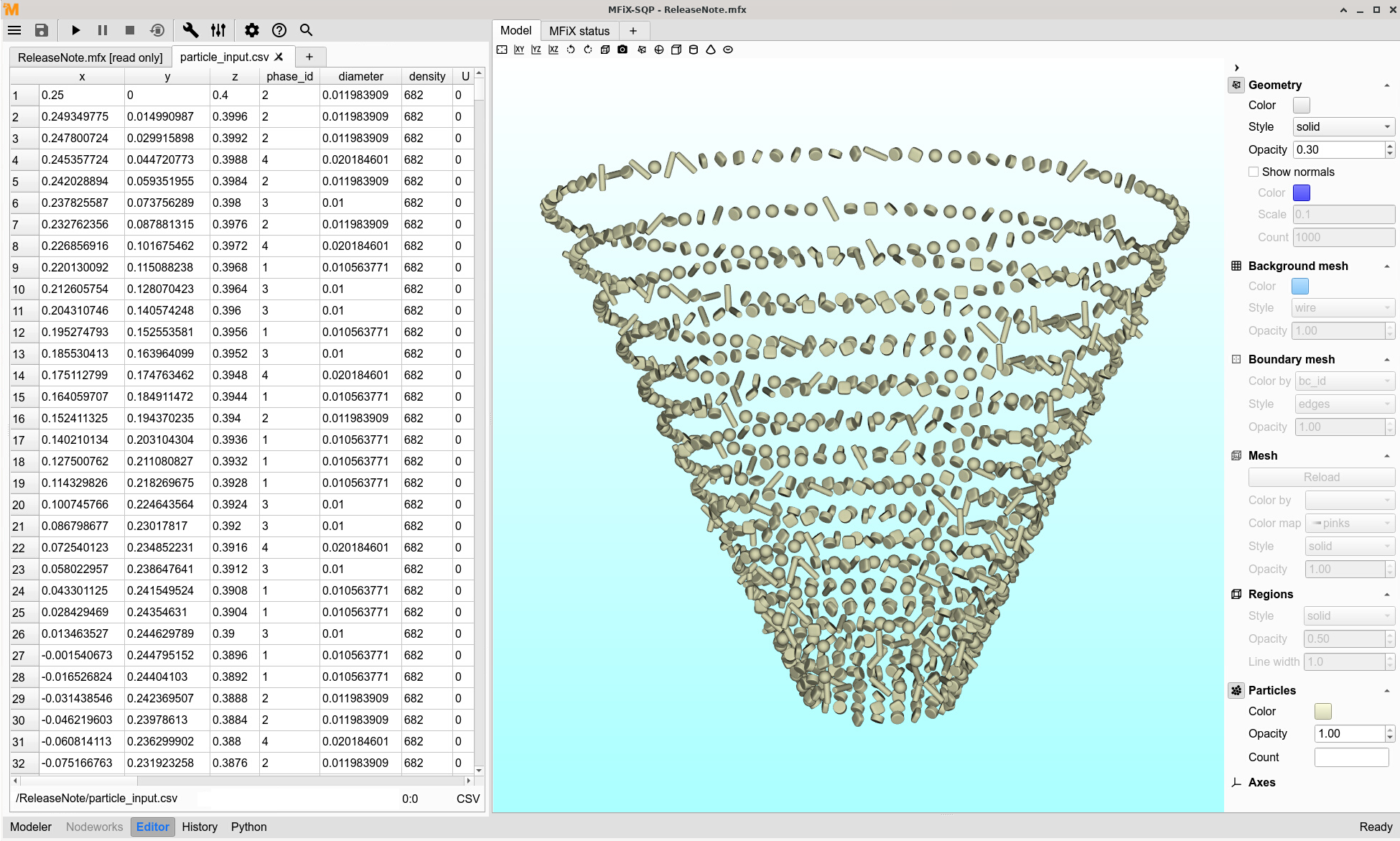
4.6.14. Particle data output file¶
The particle data can be saved into a csv file at the end of the simulation. Go to the Output pane and check “Save particle positions at end of run”. This will save a file named particle_output.csv. This file has the same format as the particle_input.csv file. It provides a convenient way to generate a csv file, with appropriate columns content. Run a first simulation by setting automatic particle generation through the Initial Condition pane, (make sure “Enable automatic particle generation” is checked in the Solids>DEM, Solids>CGP, Solids>SQP, or Solids>GSP tab), check “Save particle positions at end of run”, and run the simulation for a short duration. Rename particle_output.csv to particle_input.csv and use it for another project.
